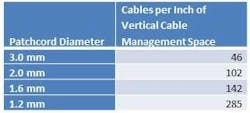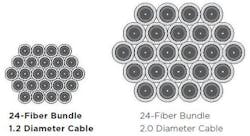The trend toward micro cabling
Smaller, faster, better -- that has been the trend in fiber-optic cabling now for many years. “Faster and better” was certainly the mantra of the 1990s with innovations such as dispersion compensation, a focus on improving optical fiber reliability, etc.
In recent years the industry has focused on reducing the footprint of optical networks. Arguably, the current trend toward ever smaller optical cables and hardware began in the mid-2000s, with optical fiber vendors developing reduced bend radius (RBR) fiber. Soon after the arrival of these new optical waveguide designs an international standard was developed to cope with them – ITU G657. Optical fibers that could be “tied in a knot” then began to enable the development of smaller cable designs due to the increased tolerance of these fibers to both macro- and micro-bending.
Macro and micro benefits from RBR fiber
Macro-bending is an easy phenomenon easy to understand. ITU G657 calls out a particular optical loss specification at particular bend radii for macro-bend performance. Improved micro-bending performance, however, is arguably the primary aspect of RBR that enables smaller, higher performing cabling. One way to practically think of the difference between macro- and micro-bending is to think of wrapping an optical fiber around your finger and measuring optical loss (macro-bending) versus pressing a piece of sandpaper down on an optical fiber and measuring loss (micro-bending loss).
The underlying optical phenomena causing signal loss in these two scenarios are quite different. When an optical cable is exposed to cold temperature, materials in a cable will tend to contract, exerting forces along the length of the optical fiber. These forces tend to induce micro-bending on optical fibers inside the cable. So the improved micro-bending tolerance of the RBR optical fiber certainly helps cables to withstand wide temperature variations, as one example.
Optical cablers around the world are taking advantage of this aspect of RBR optical fiber. The “dream,” if you will, is to have an optical cable that handles like a copper wire – rugged, small, practical, and easy for anyone to handle without damaging the optical fiber. To this end, there have also been innovations with the materials used in making optical cables. The improved bending performance of RBR optical fibers enables new materials and new manufacturing techniques to be considered for optical cabling that in turn enable the cables to be smaller and lighter weight. The puzzle pieces are coming together to make a new generation of much smaller and more resilient cabling.
One area prime for reduced diameter cabling is patchcords and other interconnect-style cabling. In addition to the obvious benefit of being able to fit more cables in the same space, having smaller optical cabling can also promote better air flow as it occupies less space in raceways. This advantage is expected to become more important as vendors of active electronics try to miniaturize and consolidate electronics bays. Heat becomes more and more of an issue in such bays. Usually, one thinks of airflow along copper cabling (which itself generates heat). But as equipment bays become smaller and hotter, all aspects of airflow become important.
Enter the new wave of even smaller interconnect cabling and patchcords…
Smaller than you think
It may not be immediately obvious, but for each unit of diameter reduction in a round cable you receive a correspondingly much greater reduction in the space the cable occupies (the area of a circle). So small diameter reductions in the cable can mean a lot of space reduction. Take some examples:
So, comparing typical 2.0-mm cabling to cable with a diameter of 1.2 mm, one can see that although the cable diameter is not reduced by even half, the recommended amount of cabling that can fit in the same space (1 square inch) is nearly 3X as much!
To illustrate this, take for example a stack of 24 patchcords. Visually, this is what the difference looks like:
From this diagram you can see the same amount of optical fibers consume a much more compact space in the 1.2-mm-diameter cable example. Similarly, comparing even a 1.6-mm diameter to a 1.2-mm diameter you can fit just over twice as many cables in the same space!
Stronger, too
The next question one might ask is about strength of these smaller cables. In the late 2000s, Telcordia issued revision 2 to the popular GR-409 interconnect cable standard. Revision 2 contained a subcategory referred to as “small form factor” cabling to enable lesser-strength cables to be produced to GR-409 standards. The so called small form factor installation tensile strength was lowered to allow 9 lbs (40N), versus the standard installation load of 22 lbs (100N). At the time, this strength reduction was thought to be needed to produce smaller and smaller cables. The 9-lb tensile rated cables arguably require a lot more care from the installer to avoid cable damage versus the 22-lb rated cables.
However, some of today’s cable based on RBR optical fibers actually use materials/designs/methods that lead to smaller cables that exceed the original 22-lb tensile installation load in GR-409.
For example, 1.2-mm interconnect cables are now on the market that support a 30-lb rated installation load. Compared to a small form factor rated 2.0-mm cable this means the new 1.2-mm-diameter cable has 3X the strength and takes up one-third the space.
So, quite soon data center managers and others will be able to install smaller cables than ever before, while not having to sacrifice cable strength by being forced to select the small form factor option of GR-409. Care should be taken when receiving quotations for GR-409 cables to be sure you know which specification of cable you are getting. Many are unaware of this distinction.
What’s next you might ask? If the cabling size can be reduced then so can that of the hardware. Expect that soon we will see smaller hardware than ever before, enabling higher densities and more compact cable management, while still preserving network reliability.
Ryan Chappell is global business development manager, optical cabling, at TE Connectivity. He began in the optics industry in 1994. Ryan has held various roles with multiple companies in research and development, engineering, marketing, and sales of optical cable, optical fiber, and other components of optical cable.


